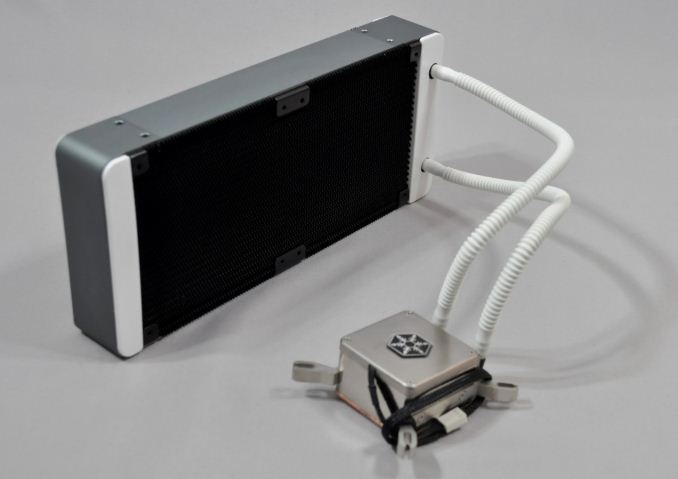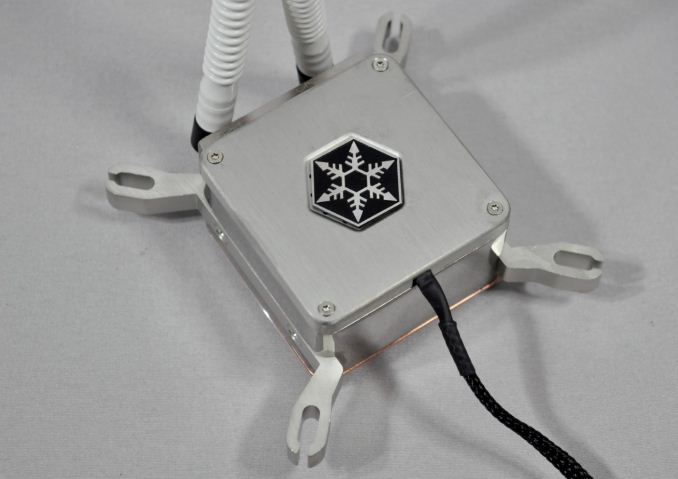Closed Loop AIO Liquid Coolers: 14-way Mega Roundup Review
by E. Fylladitakis on February 12, 2014 7:00 AM ESTSilverstone
Silverstone is another well-known name amongst advanced users and enthusiasts. The company earned their reputation from their first PSUs and original case designs and soon diversified towards cooling related products. They currently offer just two AIO liquid cooling solutions, the Tundra series. The company shipped both of them to us for this review.
Silverstone Tundra TD02
Silverstone ships the Tundra TD02 inside a large cardboard box with a black/blue theme. The box has plenty of pictures and information about the cooler printed on all of its sides. The company also supplies a fairly standard bundle with the Tundra TD02, which consists of a manual with installation instructions, mounting hardware and a syringe with thermal compound. There also is a 3-pin Y-splitter fan cable included, which can be used to power two fans off a single header. Silverstone supplies two 120mm fans with the TD02. The fans have back frames and curved, notched white blades that supposedly reduce aerodynamic noise, as well as fluid-state bearings for prolonged life. Their speed range is rather narrow, ranging from 1500 to 2500 RPM.
Visually, the Silverstone Tundra TD02 certainly stands out a lot. Although it is somewhat different, the Tundra TD02 could be coming from the same OEM that makes the Enermax Liqtech 120X as well; however, Silverstone did not want to reveal their source. The very large and deep radiator with the grey aluminum frame stands out, the size of which overwhelms any Asetek/CoolIT design. Size is not always a good thing though, as the 45mm thick design could bring serious compatibility issues, especially if the case has been designed with 27-29mm radiators in mind.
The design of the radiator is quite different from that of most other kits. Like the radiator of the Liqtech 120X, instead of wavy aluminum fins between the liquid pass-through channels, this design forms single, "seamless" fins from one side to the other, which are soldered onto the channels. The design of the fins and the overall size of the radiator though is different.
The block-pump assembly of the Tundra TD02 stands out over that of most other kits as well. It is entirely metallic, made of nickel-plated aluminum with a copper base. A badge with Silverstone's logo lies in the middle of the aluminum cap, which also has very subtle blue LEDs surrounding it. There is something unique about this block however; unlike any other assembly, including that of the Liqtech 120X, the copper base of the block is not attached to the assembly with screws, leaving the bottom of the block entirely plain. It has also been machined down to a perfect, smooth finish. The only thing that we could complain about is the use of narrow, stiff, white corrugated tubing, which is beneath the quality of such a product.
Silverstone Tundra TD03
Confusing as this may be, the Tundra TD03 actually is a smaller version of the TD02. It comes in a similarly designed cardboard box with a black/blue color theme, only it's significantly smaller. Despite the change in size however, the cooler remains very well protected within cardboard packaging and inside nylon bags. It also shares exactly the same bundle with the TD02, including the manual with the installation instructions. The two 120mm fans supplies are the same as those of the TD02, with a black frame and curved, notched white blades.
Both visually and practically, the Tundra TD03 is just a shorter version of the TD02. The radiator also shares the same design, and is just as wide and thick as the radiator of the TD02, yet nearly half as long, which means that it essentially has half the heat dissipation surface. Nevertheless, Silverstone still supplies two 120mm fans, to be used in a push-pull configuration. It is interesting to note that this radiator design appears a lot more solid, without any imperfections or bent fins, which appear to be very common on radiators with wavy aluminum fins.
As expected, the fully metallic block-pump assembly of the Tundra TD03 is identical to that of the TD02. The top and frame of the assembly are made out of nickel-plated aluminum, with the base of the block made out of solid copper. Even the mounting braces are made of solid aluminum, with those meant for Intel CPUs preinstalled on the block from the factory. Once again, the copper base is not attached to the aluminum frame with screws, at least not screws visible from the bottom of the assembly, leaving the base of the cooler perfectly clean and smooth.
























139 Comments
View All Comments
Laststop311 - Wednesday, February 12, 2014 - link
noctua d14 runs cooler and quieter. These all in 1 coolers all suffer from the same problem. The pumps used are cheap loud and not very powerful. You need to build you own water cooling loop using high quality waterblocks radiators pumps and tubing then and only then can u take the noctua d14 down, And I'd still use high static pressure noctua fans on the custom water cooling loop because noctua fans are awesometheNiZer - Wednesday, February 12, 2014 - link
E. Fylladitakis : I like the theme of the article and the approach, BUT did you use the same fan-type for all coolers? If not, that explains the lov efficiency of Coirsair H105 - it has more low noise tuned fans.You should test the units with the same fan as well to really tell the effect of the individual watercoolers.
E.Fyll - Wednesday, February 12, 2014 - link
No and I will never use any other fan than the ones supplied with the kit. I explained why thoroughly in the comments above. I cannot perform tests with a fan of my choice, as the characteristic performance of the said fan will favor some designs over others, creating misleading results. And I cannot possibly perform testing using dozens of fans either.It also increases the cost. Most people simply want to buy a cooler, not half the store. If someone wants to use different fans for whatever reason, I cannot possibly foretell how each kit will react. RPM, CFM, sound pressure levels are all next to irrelevant when a fan is going to be mounted on a heat exchanger, therefore any comparisons between fans that "look similar" are a massive mistake.
I performed noise testing, you know. If you would look at it, it is one of the noisiest kits in the roundup. So that could not have been further from the truth.
Hxx - Wednesday, February 12, 2014 - link
Why no thermaltake? I managed to snag a thermaltake performer 2.0 from Microcenter for $5 after a rebate lol last BF. It was too good to be true. They also had the extreme 2.0 for $35. Great cooler too (both of them although i kept the little one).E.Fyll - Wednesday, February 12, 2014 - link
Copy-paste from above:"I know. I actually tried to acquire all AIO coolers in existence, including Intel's, Thermaltake's and others. Not everyone is happy to cooperate and/or willing/able to supply samples at a give time, for whatever reason."
I cannot test what I cannot have access to.
Dizey - Wednesday, February 12, 2014 - link
I normally don't comment, but I just have to say that I'm also really disappointed that the Swiftech H220 isn't in this review. In all fairness, one could argue that the H220 isn't a close loop cooler, but the lack of its presence in this article does give it a fowl stench.E.Fyll - Wednesday, February 12, 2014 - link
Copy-paste from above:"I know. I actually tried to acquire all AIO coolers in existence, including Intel's, Thermaltake's and others. Not everyone is happy to cooperate and/or willing/able to supply samples at a give time, for whatever reason."
I cannot test what I cannot have access to.
Dustin Sklavos - Wednesday, February 12, 2014 - link
The H220 isn't *available.* Asetek's litigation means you can't buy it stateside, rendering its performance somewhat irrelevant.twtech - Wednesday, February 12, 2014 - link
I don't see a winner listed, but the results seem to say that, from a performance standard, if you have the room to fit it, the Corsair H110 is what you'd want to buy. It's basically a close 2nd in both performance and noise, which makes it a clear #1 overall.twtech - Wednesday, February 12, 2014 - link
And by standard I meant standpoint.